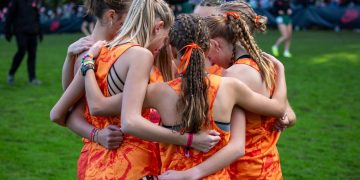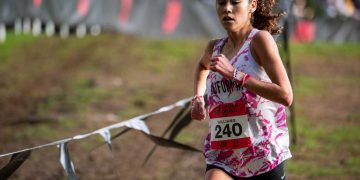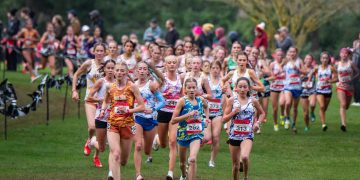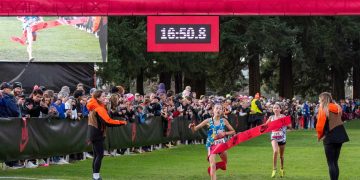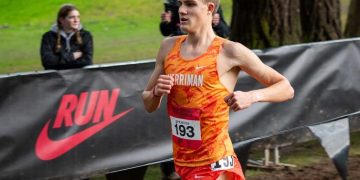Track & Field has a long and amazing history in Sacramento. The USATF communications department put together this history of some of the finest moments in Sacramento’s fine athletics history. The USATF Championships start on June 22 in Sacramento’s Hughes Stadium, and we hope that you can attend! If not, watch it via streaming video or on NBC!
RunBlogRun will be covering the meet via social media throughout the weekend plus great stories!
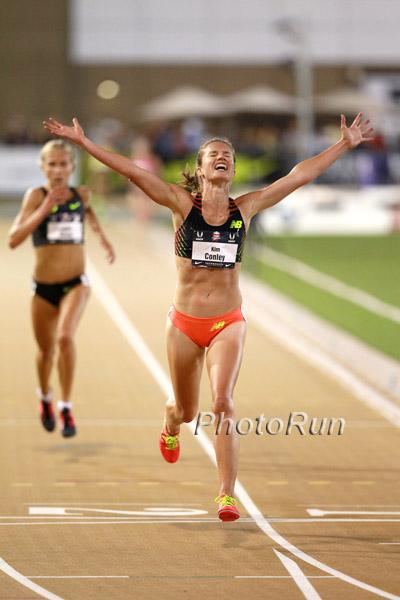 Sacramento’s Kim Conley wins the 10,000m over Jordan Hasay in 2014 USATF! photo by PhotoRun.net
Sacramento’s Kim Conley wins the 10,000m over Jordan Hasay in 2014 USATF! photo by PhotoRun.net
Sacramento Track & Field History
Sacramento figures prominently in the history of U.S. track & field over the past 50 years, starting with a legend’s historic sprint in 1966 and continuing into 2017 with the USATF Outdoor Championships.
Great facilities, excellent weather and knowledgeable fans have earned Sacramento a star on the sport’s map of outstanding track cities. The 2000 U.S. Olympic Trials set an eight-day attendance record that still stands.
Here’s a quick run down memory lane:
1966 – At the All-American Invitational at Hughes Stadium, San Jose State sprinter Tommie Smith broke the world for the 220-yard dash around a turn, clocking 20.0 seconds. Smith’s time was also a world record for the slightly shorter distance of 200 meters. Two years later, Smith won the Olympic 200-meter title and made his iconic clenched-fist protest on the victory stand in Mexico City.
1968 – The AAU Championships at Hughes Stadium will be forever known for the “Night of Speed”. In the span of two and half hours on the balmy evening of June 20, the sanctioned world record of 10.0 seconds in the men’s 100-meter dash was broken by three men and tied by seven others. “There will never be another night like it,” said Jim Hines, who clocked history’s first legal 9.9 that night. Ronnie Ray Smith and Charlie Greene also ran 9.9 that night, with Greene edging Hines in the final.
1969 – Pole vaulter Casey Carrigan surprised the track world in 1968 when he made the U.S. Olympic team as a high-school junior. The following year, at the Golden West Invitational in Sacramento, Carrigan set a national prep record of 17 feet, 4¾ inches. He then took three unsuccessful shots at the world-record height of 17-10. The spectacle of a high school athlete giving the world record a scare merited a lengthy article in Sports Illustrated.
1972 – Hughes Stadium was the site of the U.S.-U.S.S.R. junior track & field showdown. Randy Williams, a Fresno native who had just completed his freshman year at USC, defeated the Soviets with a gigantic wind-aided leap of 27 feet, 4½ inches. Williams followed up his Sacramento performance that summer with an upset victory at the 1972 Olympics in Munich, West Germany.
1979 – At the Golden West Invitational at Sacramento State, Michael Carter, a shot-putting prodigy from Dallas, powered the 12-pound ball 81 feet, 3½ inches. Thirty-four years later, no high school athlete has approached Carter’s mark. After winning a silver medal in the 1984 Olympics, Carter had a successful professional football career with the San Francisco 49ers.
1981- The TAC National Championships at Hughes Stadium featured wins in the long jump and 100-meter dash by Carl Lewis, the first such double since Jesse Owens in the 1930s. Lewis won the long jump with history’s second-longest leap – 28 feet, 3 inches.
1984 – At an international meet held at Hughes Stadium prior to the Olympics in Los Angeles, an up-and-coming star named Roger Kingdom clocked a windy 13.00 in the 110-meter hurdles. Only Renaldo Nehemiah had ever run faster under any conditions. Later that summer, Kingdom won the first of his two Olympic titles in the high hurdles.
1995 – The national championships returned to Hughes Stadium for the first time in 14 years. The star of the show was Michael Johnson, who became the first male sprinter to win the 200 and 400 meters in the same national meet since 1899. Johnson would repeat the 200/400 double at the 1995 World Championships and the 1996 Olympics.
2000 – The Sacramento Sports Commission landed the 2000 U.S. Olympic Track & Field Trials, which were held on a new Mondo track at Sacramento State. The eight-day spectacle drew more than 187,000 spectators, shattering the event’s attendance record. Local favorite Stacy Dragila broke her own world record in the women’s pole vault by clearing 15-2¼ inches. Gail Devers shattered her U.S. record in the 100 hurdles.
2003 – After a 45-year absence from Northern California, the NCAA Division I Outdoor Track & Field Championships came to Sacramento State in 2003. Texas freshman (and eventual Olympic champion) Sanya Richards set an American collegiate record in the women’s 400m (50.58), and the men’s 400m featured one of history’s best high-level photo finishes. Minnesota’s Adam Steele won in 44.47 as the top three – South Carolina’s Otis Harris (44.57) and Minnesota’s Mitch Potter (44.58) – finished inches apart.
2004 – The U.S. Olympic Trials returned to Sacramento and drew 172,230 spectators, the second-highest total in meet history behind only the 2000 meet. Defending Olympic champion Maurice Greene edged the man who would succeed him, Justin Gatlin, in a blazing 100 meters,and Jeremy Wariner of Baylor presaged his Olympic win with a 44.37-second victory in the 400 meters.
2005 – Florida’s Kerron Clement (400 hurdles) and LSU’s 4x400m relay team set collegiate records as the NCAA Outdoor Championships returned to Sacramento for the first leg of a three-year run.
2006 – LSU sprinter Xavier Carter became the first male since Jesse Owens to win four NCAA titles in the same championship meet, finishing first in the 100 and 400 meters and running legs on LSU’s victorious relay teams.
2007 – Florida State sprinter Walter Dix set an American college record in the 100-meter dash (9.93 seconds). The runner-up, Trindon Holliday of LSU, went on to have a successful NFL career as a kick returner.
2014 – The USATF Outdoor Championships returned to Sacramento after a 10-year absence. Jeff Henderson (long jump) and Michelle Carter (shot put) presaged their Olympic victories two years later with national titles in Sacramento. The shot put events were held on the grounds of the California State Capitol.




